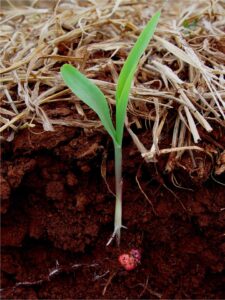
by Matt Hagny, freelance consulting agronomist for no-till systems since ’94
Everyone wants to dwell on how different their particular patch of farmland is, or the particular crop they grow, or their local climate, etc. Sure, a few of the details may be different (and as an agronomist with 24 yrs of experience, I’m definitely a details guy) from crop to crop and place to place, but the basics are always the same.
A seed needs several things to germinate (we’ll assume there’s no dormancy or hard-seed issues), which include being able to absorb enough water to sprout and sustain itself while the early root system gets established, oxygen (it’s not yet photosynthesizing), and suitable temperature. After that gets going, what the seedling needs is an easy path downward for roots, and an easy path upward for the shoot. Once emerged, the young plant needs all of the essential nutrients in an adequate supply in a location where these can be absorbed by roots, and as few root restrictions as possible. That’s about all there is to it. How your seeding equipment is outfitted and adjusted determine nearly all of these things.
“But…” I can hear you say! Sure, I neglected the details, but I want you to understand that the best way to place seeds in the soil is really all the same, regardless of crop or which continent you’re on. All the seeding equipment flavors we have been just design trade-offs and imperfect ways of doing what I just described, although some are far more imperfect than others.
Sure, optimum depth will vary—but in predictable ways (it’s not just random lists of details). Small seeds need to be shallower than large seeds, since they have less energy stores to push great distances to the surface. Depth can and should be deeper when it’s warm and dry than when cool & wet, etc.
Other universal truths: It’s never a good idea to smear the soil just below where the seed is placed—this just creates root restrictions. It’s rarely a good idea to do a lot of packing above the seed—this only slows germination, increases disease pressure, and makes it more difficult for the shoot to emerge and crown roots to grow (if it’s a grass crop). It’s always a good idea to do some seed-to-soil contact at the seed’s location, to ensure rapid and uniform germination of all the viable seeds.
And all crops need uniformity, not just corn, sunflowers, and cotton. It may not be as big of a yield effect in crops such as wheat or soybeans, but there’s still an advantage if all the plants emerge and grow at the same rate as their neighbors.
There are some other things dictated by the physical world. For instance, to obtain precise depth, that depth must be measured close to where the seed-placing action is occurring. And something must prevent the dust, duff, and chunks of sidewall from getting in ahead of the seeds.
There will, of course, be differences in how much down-force is required to hold depth, or how much pressure is needed to achieve sufficient seed-to-soil contact—but these, too, follow a pattern: more pressure is required when soils have lower moisture content, or more geologically ancient. There will be differences in how crucial it is to have excellent seed-to-soil contact, with the warmer climates and worse soils needing more attention to this. There will be differences in how important it is to use row cleaners, etc., or pop-up fertilizers—both being more important when planting into cooler soils than warm.
The vast majority of Exapta’s previous newsletters have focused on how to improve some aspect of some particular make & model of seeder (or which make & model to choose). Those are all details, and better methods will no doubt be invented in years to come. But here I’m emphasizing that the actions needed to do a good job of no-till seed placement are the same, whether it’s corn or canola, clay or sand, high OM or low OM, Russia or Australia or Oklahoma or Illinois. The seeds & seedlings all need the same basic environment to establish and prosper. There is a common theme as to the best ways to do this in no-till, and I’ve spent more time trying to understand and improve this than nearly anyone else.
For more on the details of effective seed placement in no-till using existing technology, see our tech tips for planters and tech tips for drills.
